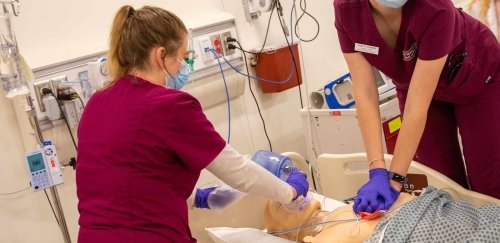How to Prepare for Simulation

Why Preparation is Important
Healthcare simulations create a realistic scenario that you may likely encounter when working in a medical setting. Because of the use of simulators (technology-enhanced simulation manikins), actors, medical/diagnostic equipment, demonstration-drugs, and contrived problems the simulation may be slightly stressful. Knowing what to expect in a simulation can help alleviate concerns and allows a practitioner to keep calm and make reasonable decisions.
Topics to Review
- Find Out as Much as You Can About Your Simulation Day
- Visit the Lab Prior to Participating in Simulation
- Familiarize Yourself with the Computerized Manikins
- Understand What You Can and Cannot Do with the Manikins
- Simulation Pre-briefing
- Participating in a Simulation With Actors
- Debriefing
- Simulation Outcomes
- Experiential Learning
Find Out as Much as You Can About Your Simulation Day
- Ask your professor for preliminary case notes.
- Refer to assigned readings relating to the simulation case(s).
- Complete virtual simulations if assigned.
- Practice using simulation equipment during OPEN LAB/SIM practice.
- Review techniques and procedures used in standard patient care situations such as taking vital signs and assessing heart, lung and bowel sounds. Practice these skills on simulation manikins.
- Review nursing assessments appropriate for case (newborn, child, young adult, adult, geriatric).
Visit the Lab Prior to Participating in Simulation
- Ensure you are familiar with the type of environment used for each simulation you encounter throughout your nursing program.
- Simulations occur at two locations: RIC Campus and RINEC Downtown.
- Determine your own learning needs and visit the lab (RIC or RINEC) to explore the environments (like you do in real world clinical placements).
- Ask questions! The simulation educators and staff are glad to help!
Familiarize Yourself with the Computerized Manikins
- The adult manikins vary in technology.
- The 3G Sim Man has reactive pupils, can blink, speak, and has a blood pressure, pulses, lung sounds and bowel sounds. One vascular access site (IV) allows students to manage intravenous fluids, blood transfusions and medications. Yes, you can push meds into the manikin’s IV!
- If needed, other procedures can be performed such as urinary catheterizations, chest tubes insertions, intubations, and intraosseous (IO) access.
- Sim Junior Child Manikin is the same as 3G except does not blink and pupils DO NOT react to light.
- Sim Baby Infant Manikin is the same as above.
- Sim Mom
- Sim Pad Manikins have wireless capability for great on the fly practice sessions!
Understand What You Can and Cannot Do with the Manikins
- Never position any manikin in a super high sitting position, as this can damage the arms.
- Don’t use pen or ink on the manikins as this will cause permanent stains.
- Wear gloves when working with the manikins to protect your simulated patient’s skin.
- Report any unexpected malfunctions so the simulation team can inspect and correct any technical issues.
Simulation Pre-briefing
Prior to simulation, as participating learners you should:
- Respect confidentiality of all materials, “What happens in simulation stays in simulation,” as this is an extension of the academic honesty policy.
- Behave in a professional manner respecting others perspectives while learning.
- Commit to a ‘fiction contract’ that simulation mimics real practice, but occurs in a safe learning environment without the risk of harm to real patients.
- Understand the term ‘psychological safety’ means if you ever feel too uncomfortable, you can always “opt out”. Speak with your professor so we can support you.
- Prepare yourself to explore and learn that most often leads to an increase in self-confidence and applied skills.
Participating in a Simulation With Actors
Learning with actors characterizing various roles (patients, family members, bystanders).
- Actors are trained to portray the physical, emotional and spiritual dimension of being human.
- This results in a 3-dimensional experience that is markedly different when compared to simulations using only manikins.
- The depth of experience can trigger strong emotions.
- The life-like portrayal nearly replicates a patient’s reality in a moment to moment unfolding drama.
- Cues to pain or distress are more apparent when actors take part in simulation.
- Actors are professionals and are only portraying characteristics needed for the learning to occur.
- Actors often contribute to simulation debriefing for added perspectives from the patient or family member’s viewpoint.
Debriefing
- Simulation learning comes full circle during debriefing.
- Debriefing is a collaborative dialogue session with learner participants and observers, and sometimes actors that is facilitated with specially trained simulation educators and faculty.
- Debriefing occurs in a respectful, safe and inclusive environment where everyone’s perspective is important.
- Challenges may occur when conversations stray, but facilitators steady the conversations so achieving the goal of making sense of the simulation experience as a whole.
- It is often said, that in debriefing, the transformations in thinking occur.
- Many styles of debriefing are used depending on the level of the learners, the learning objectives, and overall goals of the clinical simulated experience.
Simulation Outcomes
Assessing the simulation experiences for positive outcomes is a prime consideration for educators.
Post-simulation surveys are available electronically after each simulation by signing on the CAE Learning Space at:
Please Note: Please fill out post-evaluation surveys immediately after completing debriefing sessions.
Experiential Learning
- Kolb (1984) is best known for developing the Theory of Experiential Learning that includes a cycle of events that begins with concrete experience (CE), reflective observations (RO), abstract conceptualizations (AC), and active experimentation (AE)
- The NLN Jeffries Simulation Theory (2016) recognizes the importance of interdisciplinary collaboration in developing simulation experiences.
- The importance of using simulation as a teaching method ensures students the opportunity to engage in clinical reasoning and critical thinking in a safe environment. Students develop critical skills (psychomotor, cognitive, interprofessional, and interpersonal) prior to professional practice in real clinical situations.
Simulation Accreditation
A Society for Simulation in Healthcare (SSH) Accredited Program Teaching/Education. Awarded Accreditation 2014, 2020–2025

Simulation Questions?

